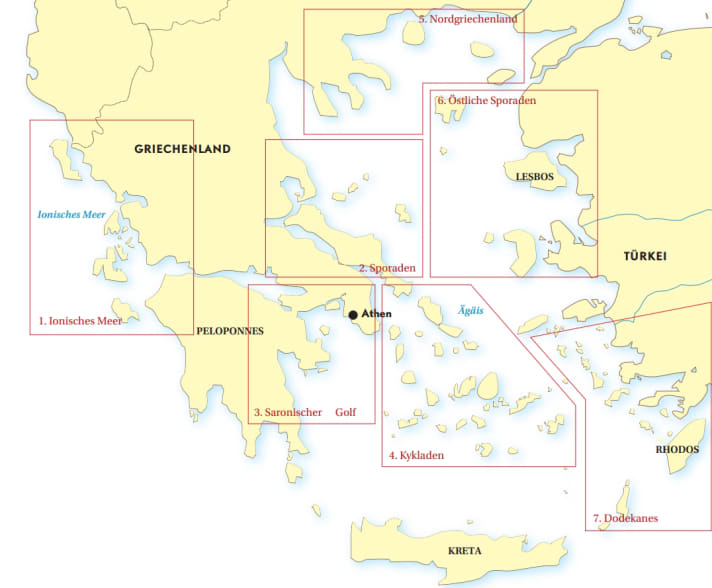





Over 3000 islands, but only around 100 of them inhabited: the Greek waters are a huge area. The big question, especially for beginners, is: Which region in Greece is the right one for me? The rather green, light-winded Ionian Sea? Or the barren, windswept Cyclades with their white cube-shaped houses? And what distinguishes the Dodecanese islands, which are quite close to each other, from the Cyclades? Our portrait of the area provides a guide to the different levels of difficulty, infrastructure and character of the islands.

1. the Ionian Sea
The classic area for beginners or crews who don't want to be travelling in the windier Aegean. There are two main starting harbours that are easy to reach with direct flights from Germany: Corfu in the north and Lefkas/Palairos (Preveza Airport) in the centre of the area. The start in Corfu makes the longer trip to and from Lefkas (about 30 nautical miles) necessary at the beginning and end. The Ionian Islands are very green and mountainous, and the smaller islands of the archipelago are perfectly protected by the lee of Lefkas, Kefalonia and Ithaca. The distances there are correspondingly short. Caution: In summer, however, the Ionian Sea is the busiest sailing area in Greece. There is often a calm at night and the region tends to be thermally dominated in summer. In spring and autumn, on the other hand, there is a lot of southerly wind and thunderstorms.
2. sporades
Small-scale island area in the north, where the Meltemi is somewhat weaker. You start in the Gulf of Volos and head for the three pretty main islands of Skiathos, Skopelos and Alonnisos, including smaller neighbouring islands. Perhaps also plan a detour to Euboea. The choice of route is somewhat less flexible than in the larger Aegean regions. As everything is so manageable, you can easily spend a week travelling here, but even two weeks won't be boring. The flight connections to Volos were difficult, as there were very few direct flights from Germany.
3. the Saronic and Argolic Gulfs
The area a little south-west of Athens is popular for a short week's cruise. With Aegina, Poros, Hydra, Dokos and several mainland harbours, it is a beautiful holiday destination, but is somewhat overcrowded in summer, especially at weekends. The harbours are bursting at the seams, especially Hydra, which is notorious for anchor chaos, but is also beautiful. Short distances, and from Hydra onwards the coast offers some protection from the Meltemi. A beginner's alternative to the Ionian Sea for less experienced crews, but not in July and August. If you have more time, you can simply extend the area to include the Argolic Gulf and the beautiful east coast of the Peloponnese.
4th Cyclades
They are the royal territory of the Aegean. The strongest Meltemi winds blow here and the distances between the islands are comparatively long. But there is plenty of variety. Some cult islands, such as Santorini or Mykonos, are well worth the trip. The characters of the islands are so different that there is always something new to discover. The Cyclades are windswept, bare and offer the typical panorama of white cube houses on steep slopes. There are plenty of good anchorages, but almost only relatively simple municipal harbours. At Meltemi, the moorings with bow anchors are sometimes challenging. Something for experienced skippers who are not afraid of strong winds. But even this is often weathered in shorts and a T-shirt, while the sea shines a deep blue and the sky the same. If you want to approach the area carefully, come in the early or late season, i.e. from May to early June or late September to mid-October. The starting harbours are Athens or Lavrion, which is better for a week.
5. northern Greece
The area to the south of Thessaloniki around the three fingers of the Halkidiki peninsula is still an absolutely developing country in terms of boating tourism. However, it is far less crowded and the Meltemi is much weaker. However, the distances between destinations are sometimes long. The area is famous for the Orthodox monks' republic on Mount Athos, which can only be visited with a pilgrimage permit.
6. eastern Sporades
The area around Samos and Lesbos has fallen somewhat by the wayside in recent years due to the influx of refugees there and the border crossing with Turkey, which is not to be recommended. The number of smaller islands that can be added to the itinerary is limited. Something for Greece connoisseurs who are looking for something new
7th Dodecanese
The ideal alternative to the Cyclades if you want to avoid the long hauls. The distances between the islands, which are also rather barren, are shorter, so there is always more shelter. On top of that, there are three good marinas here: Kos, Leros and the new one in Rhodes (not the city harbour). The Meltemi is also strong in summer. Good journey with direct flights to Kos or Rhodes. It is ideal to explore the northern islands from Kos against the Meltemi. Kalymnos, Leros, Lipsi and Patmos have enchanted every visitor. There are very sheltered bays, some buoy fields in front of tavernas and good harbours. At the end, return with the wind or sail even further towards the southern islands. This requires 14 days. Or you can start a week northwards from Rhodes.

